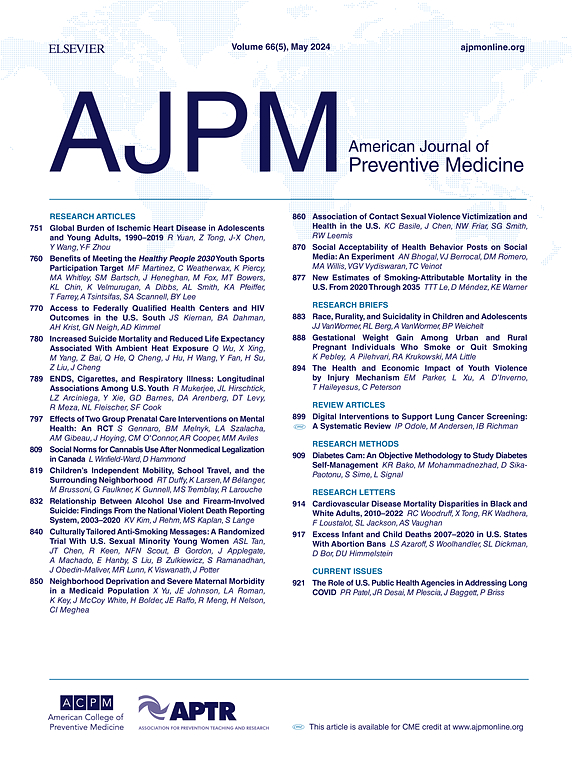双胞胎可步行性与身体活动的纵向关联。
IF 4.3
2区 医学
Q1 MEDICINE, GENERAL & INTERNAL
引用次数: 0
摘要
导言:研究主要集中在支持或阻碍身体活动的建筑环境(例如,社区步行能力),因为它是潜在的可修改的。本研究调查了一个成年双胞胎队列中邻里步行能力的变化和身体活动的变化之间的关系。方法:对来自社区登记处的7,439对同卵和异卵双胞胎(包括2,800对完整双胞胎)的纵向数据(2009-2020)进行分析。参与者没有行动限制,并在目前的居住地居住至少1年。一系列“表型”(非遗传信息)模型被用来测试可步行性变化对身体活动变化的影响。通过利用双胞胎设计的遗传信息特性,在控制遗传和共同环境混杂的情况下,测试步行性变化对身体活动变化的影响,在一系列“准因果”模型中对这些进行了重新估计。结果:社区步行能力的变化与社区步行的变化有关,但与中等到剧烈的身体活动无关,在控制了遗传和共同环境混杂因素,加上标准人口统计协变量,随访时间和移动状态后,这一点仍然存在。社区步行能力每增加1个单位,每周社区步行量增加2.7分钟,这与家庭混杂因素和协变量无关。搬到一个可步行性高5.5个单位的社区,每周可以增加大约15分钟的步行时间。结论:本研究支持社区步行性变化与社区步行变化之间的“准因果”关系,通过建立时间性扩展了先前在同一双胞胎队列中的横断面研究结果。本文章由计算机程序翻译,如有差异,请以英文原文为准。
Longitudinal Association Between Walkability and Physical Activity in Twins
Introduction
Research has focused on the built environment (e.g., neighborhood walkability) that supports or hinders physical activity because it is potentially modifiable. This study investigated the associations between changes in neighborhood walkability and changes in physical activity in an adult twin cohort.
Methods
Longitudinal data (2009–2020) from 7,439 identical and fraternal twins comprising 2,800 complete pairs from a community-based registry were analyzed. Participants were free of mobility limitations and resided at their current residential location for at least 1 year. A series of phenotypic (nongenetically informed) models were used to test the effect of walkability change on change in physical activity. These were re-estimated in a series of quasi-causal models by leveraging the genetically informed nature of the twin design to test the effect of walkability change on change in physical activity while controlling for genetic and shared environmental confounds.
Results
Change in neighborhood walkability was associated with change in neighborhood walking but not in moderate-to-vigorous physical activity, which held after controlling for genetic and shared environmental confounding, plus standard demographic covariates, length of follow-up, and moving status. A 1-unit increased change in neighborhood walkability was associated with a 2.7-minute increased change in neighborhood walking per week, independent of familial confounds and covariates. Moving to a neighborhood that is 5.5 units greater in walkability could increase neighborhood walking by about 15 minutes per week.
Conclusions
This study supports a quasi-causal relationship between changes in neighborhood walkability and changes in neighborhood walking, extending previous cross-sectional findings in the same twin cohort by establishing temporality.
求助全文
通过发布文献求助,成功后即可免费获取论文全文。
去求助
来源期刊

American Journal of Preventive Medicine
医学-公共卫生、环境卫生与职业卫生
CiteScore
8.60
自引率
1.80%
发文量
395
审稿时长
32 days
期刊介绍:
The American Journal of Preventive Medicine is the official journal of the American College of Preventive Medicine and the Association for Prevention Teaching and Research. It publishes articles in the areas of prevention research, teaching, practice and policy. Original research is published on interventions aimed at the prevention of chronic and acute disease and the promotion of individual and community health.
Of particular emphasis are papers that address the primary and secondary prevention of important clinical, behavioral and public health issues such as injury and violence, infectious disease, women''s health, smoking, sedentary behaviors and physical activity, nutrition, diabetes, obesity, and substance use disorders. Papers also address educational initiatives aimed at improving the ability of health professionals to provide effective clinical prevention and public health services. Papers on health services research pertinent to prevention and public health are also published. The journal also publishes official policy statements from the two co-sponsoring organizations, review articles, media reviews, and editorials. Finally, the journal periodically publishes supplements and special theme issues devoted to areas of current interest to the prevention community.
 求助内容:
求助内容: 应助结果提醒方式:
应助结果提醒方式:


